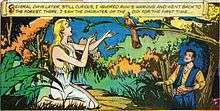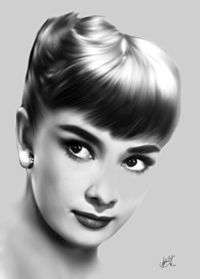Rima

Rima, also known as Rima the Jungle Girl, is the fictional heroine of W. H. Hudson's 1904 novel Green Mansions: A Romance of the Tropical Forest. In it, Rima, a primitive girl of the shrinking rain forest of South America, meets Abel, a political fugitive. A movie of Green Mansions was made in 1959 with Audrey Hepburn as Rima. In 1974, the character, Rima, was adapted into a comic book character and featured in the monthly series Rima the Jungle Girl, published by DC Comics. Though Rima the Jungle Girl ceased publication in 1975, the comic book version of Rima appeared in several episodes of Hanna-Barbera's popular Saturday morning cartoon series, The All-New Superfriends Hour, between 1977 and 1980.

Novel
Like her literary cousins Tarzan and Mowgli, Rima sprang from an Edwardian adventure novel; in her case, Green Mansions: A Romance of the Tropical Forest, by W. H. Hudson, published in 1904. Hudson was an Argentine-British naturalist who wrote many classic books about the ecology of South America. Hudson based Rima on a South American legend about a lost tribe of white people who lived in the mountains.[1] The book has a religious tone and Rima's speech is poetic.[2] It is a romantic adventure set in the South American jungle in which a political fugitive named Abel meets Rima, a girl living in the forest.[3] Its theme is the loss of wilderness and the return-to-nature dream, and how unpleasant it would be for a savage to meet modern man.[4]
Movie
Actor and director Mel Ferrer adapted Green Mansions into a 1959 film for MGM Studios, with Audrey Hepburn as Rima. [5] The adaptation deviated far from the novel.
Comic books
| Rima | |
|---|---|
|
Rima the Jungle Girl #6 (March 1975). Art by Nestor Redondo. | |
| Publication information | |
| Publisher | DC Comics |
| First appearance |
Historical: 1904 Modern: 1974 |
| Created by | W. H. Hudson |
Rima starred in a seven-issue comic book series, DC Comics' Rima the Jungle Girl (May 1974 - May 1975), adapted by an uncredited writer and with artwork by penciler-inker Nestor Redondo and covers by Joe Kubert. DC writer-editor Robert Kanigher is the credited writer from issue #5 on. Debuting in March 2010, she now appears in a new DC Comics limited series First Wave, written by Eisner Award winning writer Brian Azzarello. Rima is portrayed as a South American native with piercings and tattoos; she doesn't speak, but instead communicates in bird-like whistles.[6] Although the DC character is a fully grown and powerful woman with ash blonde hair, the novel's Rima was 17, small (4' 6"), demure, and dark-haired. Natives avoided her forest, calling her "the Daughter of the Didi" (an evil spirit). Rima's only defense was a reputation for magic earned through the display of strange talents such as talking to birds, befriending animals, and plucking poison darts from the air. Although in the original book Rima was burned alive by Indians, in the comics she escaped the fire to have further adventures.
Comic book titles
These comic book titles feature the Rima character
Classics Illustrated #90: Green Mansions
Classics Illustrated published a short adaptation from the novel, with direct quotes. In this adaptation Rima is blond. (Copyright December 1951 Gilberton Company).
Rima The Jungle Girl
Title character 1974-1975
The League of Extraordinary Gentlemen
Rima is mentioned, but not seen, in America's Best Comics' The League of Extraordinary Gentlemen vol. 2, #3 (2003), by writer Alan Moore and artists Kevin O'Neill and Ben Dimagmaliw: "...it is near here that the world-famous 'bird girl' Riolama or Rima was discovered..."
First Wave
Rima is re-imagined in DC's 2010 title First Wave
Cartoons
The All-New Super Friends Hour
Rima the Jungle Girl appeared in three episodes of Hanna-Barbera's The All-New Super Friends Hour during the 1977-78 season, alongside such mainstays as Aquaman, Batman, and Wonder Woman. In her run with the Superfriends TV series, she is often known for being one of the new 'affirmative action heroes' during that period. Along with characters Apache Chief, Black Vulcan, El Dorado and Samurai, Rima is considered a minority character.
Fire
First aired: Saturday October 1, 1977; ABC (8 minutes) Batman, Robin, and Rima the Jungle Girl contend with a spreading forest fire, and have to search for a pair of escaped prisoners who have stolen a forestry truck filled with dynamite. Rima's main contribution is to call upon a nearby bear to push down some trees for an emergency bridge across a wide gap.
River Of Doom
First aired: Friday November 4, 1977; ABC (8 minutes) Wonder Woman and Rima the Jungle Girl search for archaeologists who have accidentally stumbled onto a burial ground of angry natives. The archaeologists are captured and sentenced to death on the River of Doom. The superheroes find the would-be victims by using indigenous animals to scout them out at Rima's command. They later rescue the scientists. Rima's main contribution is summoning crocodiles to attack their pursuers' canoes.
Return Of Atlantis
First aired: Saturday October 25, 1980; ABC (7 Minutes) Aquaman is captured by Queen Ocina when the lost city of Atlantis rises from the sea. Ocina plans to conquer the world with her female warriors, but Wonder Woman and Rima gather the Amazons of Paradise Island to stop her. Note: In breach of both DC Comics' and the Super Friends TV show's continuities, this "Atlantis" is not the kingdom over which Aquaman reigns.
Other appearances
Rima was mentioned in Ray Bradbury's 1950 short story, The Veldt. Rima was also mentioned in "Watcher in the Shadows" by Geoffrey Household (1960; reissued 2010) and also in "Vane Pursuit" by Charlotte MacLeod (1989).
Statue
The Hudson Memorial in London's Hyde Park, created in 1925, has a bas-relief of Rima the Bird Girl sculpted by Jacob Epstein.[7]
References
- ↑ Schmidt, Rob (November 11, 2009). "Rima the "Native" white girl". Newspaper Rock. BlueCornComics.com. Retrieved May 28, 2014.
- ↑ Google Books About page for the 1989 edition.
- ↑ Google Books About Page of the 1943 edition.
- ↑ Google Books About page of 1916 edition.
- ↑ IMDB, Green Mansions (1959), Full Cast & Crew
- ↑ Segura, Alex (November 9, 2009). "How About Some More Rags Morales' Sketches From First Wave?". The Source. DC Comics.com. Retrieved November 10, 2009.
- ↑ http://londonist.com/2013/09/the-day-peter-pan-was-tarred-and-feathered.php Image of statue with history of praise and criticism
External links
- Rima the Jungle Girl at the Grand Comics Database
- Rima the Jungle Girl at the Comic Book DB
- Rima at the Internet Movie Database
- Fantastic Victoriana: R by Jess Nevins
- Full Text of the Novel: Green Mansions
